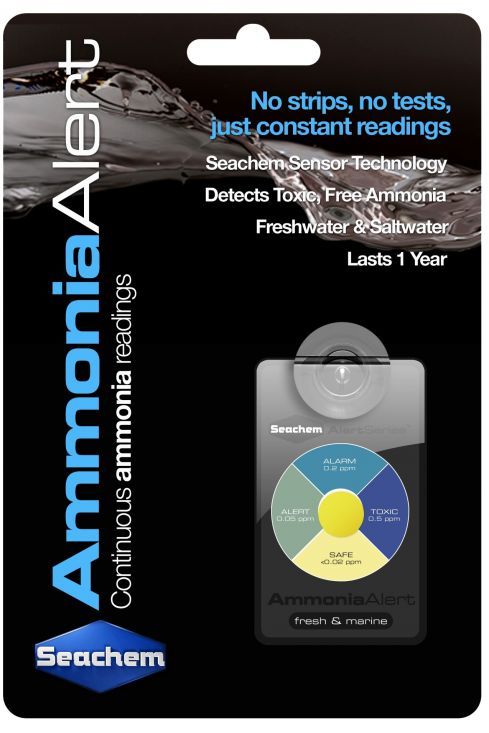Ammonia Alert™ is an innovative color device for continuously detecting and monitoring toxic free ammonia. A sensor changes reversibly from yellow to green to blue, relative to the ammonia concentration. No test kits, chemicals, or procedures are needed. The device detects less than 0.05 mg/L (ppm) free ammonia and alerts you to the #1 killer before any sign of stress. It lasts over a year. Marine or freshwater use.
In the absence of free ammonia the unit will assume a yellow or faint yellow-green color. It is normal for the dry sensor to have a greenish hue. It may take up to a few days for a dry sensor to equilibrate with the water. No sampling of water, chemicals, or test procedures are required. The presence of the free ammonia is detectable continuously with a response time of about 15 minutes. Response to decreasing ammonia is slower, requiring about 4 hours to go from TOXIC to SAFE on removal of ammonia.
Why Its Different
Ammonia Alert™ lasts over 9 times as long as competing products (over a year compared to 4-6 weeks). Ammonia Alert™ is also almost half the size of competing products. It's small, clear, and unobtrusive, so it won't detract from the view of your aquarium.
Interpretation
As little as 0.02 mg/L of free ammonia will produce a greenish hue on the detector surface. This corresponds to a total ammonia (both ionized and free ammonia) of 0.25 mg/L in marine water at pH 8.3. In freshwater at pH 7.0, this corresponds to 3.6 mg/L total ammonia. Free ammonia is much more toxic than ionized ammonia. As free ammonia, the ALERT color corresponds to about 0.05 mg/L, ALARM to about 0.2 mg/L, and TOXIC to about 0.5 mg/L. The ALERT concentration is tolerated for several days, ALARM for a few days, and TOXIC is rapidly harmful. This product is not recommended for use at acid pH.
Care
No care is required beyond removing algae with a clean, soft material. Avoid touching the sensor with fingers, since skin oils can damage it. Do not use bleach, soap, detergents or hard objects to clean the sensor. Some dye medications may discolor the sensor. Sensitivity improves with age, provided the unit is not allowed to dry out, however, drying does not permanently impair the unit. For maximum sensitivity, the unit should be read under natural daylight or daylight simulating light. Red enhancing light minimizes green and blue hues, decreasing the apparent sensitivity of the unit. The response of the unit may be checked by holding it briefly over the mouth of an ammonia bottle: color should develop rapidly.


